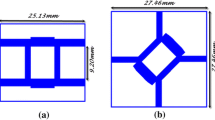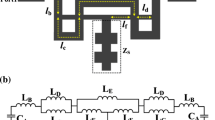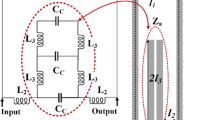Abstract
In this paper, two new compact branch-line couplers (BLCs) are proposed. The first is designed and implemented using D-CRLH unit cells made of copper microstrip line. The new design occupies only 52 % of the area of the conventional BLC that operates at 1.8 GHz. The structure has been fabricated and the experimental results have been compared to the simulated ones and very good agreement has been obtained. Advanced design system circuit simulator and the CST full wave EM simulator have been used to simulate the proposed BLCs. The second BLC is designed using YBCO high-temperature superconducting (HTS) microstrip rather than copper to achieve low insertion loss, and more compact size. Three cases of this coupler with different substrate materials are studied. The design of YBCO on lanthanum aluminate (LAO) substrate attains an optimum BLC performance compared to the one using D-CRLH. All parameters of the second design are enhanced compared to the first one, the insertion loss is enhanced from −0.1268 to −0.007 dB, return loss is enhanced from −35 to −41 dB, isolation is enhanced from −25 to −36 dB, and the area is reduced from 246 to 53.55 mm2. Moreover, the tunable frequency BLC is designed using thin film layer of BST ferroelectric material, the layer is sandwiched between the LAO substrate and HTS microstrip line, the response shows a variation of the center frequency work with the applied electric field, and the ferroelectric thickness.
















Similar content being viewed by others
References
Chang, K. (2000). RF and microwave wireless systems, chapter 4. Hoboken: Wiley.
Pozar, D. M. (2012). Microwave engineering, chapter 7. Hoboken: Wiley.
Caloz, C., & Itoh, T. (2005). Electromagnetic metamaterials, transmission line theory and microwave applications. Hoboken: Wiley.
Nguyen, Caloz C. H. V. (2007). Novel broadband conventional and dual-composite right/left-handed (C/D-CRLH) metamaterials: properties, implementation and double-band coupler application. Applied Physics A, 87, 309–316.
Caloz, C., Sanada, A., & Itoh, T. (2004). A novel composite right-/left-handed coupled-line directional coupler with arbitrary coupling level and broad bandwidth. IEEE Transactions on Microwave Theory and Techniques, 52(3), 980–992.
Guo-Cheng, Wu, Wang, Guang-Ming, Li-Zhong, Hu, Wang, Ya-Wei, & Liu, Cang. (2013). A miniaturized triple-band branch-line coupler based on simplified dual-composite right/left handed transmission line. Progress in Electromagnetics Research C, 39, 2–10.
Safwat, A. M. E. (2009). Microstrip coupled line composite right/left-handed unit cell. Microwave and Wireless Components Letters, IEEE, 19(7), 434–436.
Safwat, A. M., Ibrahim, A. A., Othman, M. A., Shafee, M., & Abuelfadl, T. M. (2013). Stub based equivalent circuit models for even/odd mode dual CRLH unit cells. Progress in Electromagnetics Research M, 30, 195–209.
Hong, J.-S. G., & Lancaster, M. J. (2004). Microstrip filters for RF/microwave applications, chapter 7 (Vol. 167). Hoboken: Wiley.
Ku, H. S., Mallet, F., Vale, L. R., Irwin, K. D., Russek, S. E., Hilton, G. C., & Lehnert, K. W. (2011). Design and testing of superconducting microwave passive components for quantum information processing. IEEE Transactions on Applied Superconductivity, 21(3), 452–455.
Zhang, G., Lancaster, M. J., & Roddis, N. (2007). HTS microstrip hybrid couplers for radio astronomy C-band receivers. In Microwave Symposium, IEEE/MTT-S International. IEEE.
Corona, A., & Lancaster, M. J. (2003). A high-temperature superconducting Butler matrix. IEEE Transactions on Applied Superconductivity, 13(4), 3867–3872.
Simon, R. W., Hammond, R. B., Berkowitz, S. J., & Willemsen, B. A. (2004). Superconducting microwave filter systems for cellular telephone base stations. Proceedings of the IEEE, 92(10), 1585–1596.
Tagantsev, A. K., Sherman, V. O., Astafiev, K. F., Venkatesh, J., & Setter, N. (2003). Ferroelectric materials for microwave tunable applications. Journal of Electroceramics, 11(1-2), 5–66.
Vendik, I. B., Vendik, O. G., Odit, M. A., Kholodnyak, D. V., Zubko, S. P., Sitnikova, M. F., & Lee, C. W. (2012). Tunable metamaterials for controlling THz radiation. IEEE Transactions on Terahertz Science and Technology, 2(5), 538–549.
Advanced Design System ADS Ver. 2011.
CST Microwave Studio Ver. 2012.
Vendik, O. G., Vendik, I. B., & Kaparkov, D. I. (1998). Empirical model of the microwave properties of high-temperature superconductors. IEEE Transactions on Microwave Theory and Techniques, 46(5), 469–478.
Miranda, F. A., Subramanyam, G., Van Keuls, F. W., Romanofsky, R. R., Warner, J. D., & Mueller, C. H. (2000). Design and development of ferroelectric tunable microwave components for Ku and K-band satellite communication systems. IEEE Transactions on Microwave Theory and Techniques, 48(7), 1181–1189.
Vendik, O. G., Ter-Martirosyan, L. T., & Zubko, S. P. (1998). Microwave losses in incipient ferroelectrics as functions of the temperature and the biasing field. Journal of Applied Physics, 84(2), 993–998.
Wu, C.-J. (2002). Simulations of microwave characteristics of high-temperature superconducting microstrip lines by using an empirical two-fluid model. IEEE Transactions on Applied Superconductivity, 12(2), 1776–1783.
Shaw, T., Suo, Z., Huang, M., Liniger, E., Laibowitz, R., & Baniecki, J. (1999). The effect of stress on the dielectric properties of barium strontium titanate thin films. Applied Physics Letters, 75(14), 2129–2131.
Tagantsev, A. K., Sherman, V. O., Astafiev, K. F., Venkatesh, J., & Setter, N. (2003). Ferroelectric materials for microwave tunable applications. Journal of Electroceramics, 11(1–2), 5–66.
Author information
Authors and Affiliations
Corresponding author
Additional information
An erratum to this article is available at http://dx.doi.org/10.1007/s11277-017-4135-1.
Rights and permissions
About this article
Cite this article
Gomha, S., Shalaby, AA.T., El-Rabaie, ES.M. et al. Thin Film Ferroelectric Compact Branch-Line Coupler Based on D-CRLH Unit Cell and YBCO HTS Microstrip. Wireless Pers Commun 89, 331–349 (2016). https://doi.org/10.1007/s11277-016-3268-y
Published:
Issue Date:
DOI: https://doi.org/10.1007/s11277-016-3268-y




